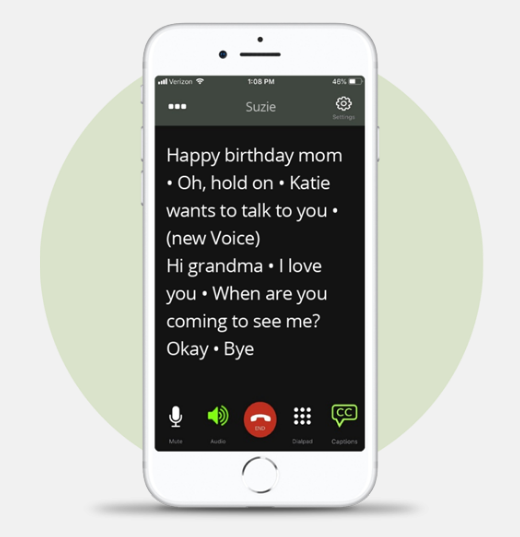|
www.HealthyHearing.com |
Captioned phones and apps
By Susanne Jones, BC-HIS, customer support manager, Healthy Hearing Last updated on: July 29th, 2025 For people with hearing loss, captioned phones and caption apps make communication with friends, family and colleagues easier. Here's what you need to know about captioned phones and smartphone apps. Key points:
For people with hearing loss, talking on a standard phone can be difficult—even with hearing aids or cochlear implants—because telephones don’t transmit the full range of speech frequencies. Many people with hearing difficulties may avoid phone calls altogether or rely on others, which can make communication harder and more isolating. Fortunately, captioned phones offer a helpful solution and are often available for free or at a low cost through government programs. What are the benefits of captioned phones for people with hearing loss?Captioned telephones are readily available, relatively inexpensive, easy to use and can be used with hearing aids or without. They can have issues, such as a slight lag in captions or minor captioning inaccuracies. However, the benefits can be substantial. Users often say they feel more connected to friends and family, and many workplaces provide captioned phones for employees who are deaf or hard of hearing. 
conversations in real-time. Features vary by model, but most captioned phones offer:
Some models of captioned phones come with Bluetooth™ technology, which allows you to listens to conversations on a headset or neckloop. How phone captioning worksWhen a call is made, the captioned phone (landline or via the app) automatically connects to a Captioned Telephone Service (CTS). When the other person answers the phone, the caller hears whatever they say just like with a traditional telephone call. At the same time, the CTS uses advanced voice recognition technology and specially trained communications assistants to transcribe everything that is said into captions, which appear almost simultaneously on the phone display. Are captioned phones free?Thanks to the ADA guidelines for hearing loss, it is possible to get free captioning services, and in many cases, the phone itself will be free or discounted (landline only). This is regulated by the Federal Communications Commission (FCC) Telephone Relay Services. To get these free services, you generally have to register to use and self-certify that you have hearing loss that impairs your ability to use a standard phone. Federal regulations prohibit the use of captioned telephone services by people who don't have a hearing loss that necessitates it. Note that this service is a little different than IP (internet protocol) Relay Service, which allows you to use a similar service, but via your smartphone or other device. You still have to pay for the smartphone separately. How do I get a captioned phone?You can ask your hearing care provider for help, or sign up directly with a captioned telephone retailer (see below). Many people qualify for special state programs where they can obtain a captioned phone at a reduced rate or for free. Some captioned telephone providers offer free delivery as well as installation, set-up and user training at no charge. In some programs, FCC regulations require a professional certification form signed by a hearing care practitioner or other health services professional to receive a free captioned telephone and captioned telephone service. The form certifies that a person has hearing loss. Are my calls private?Yes. FCC-regulated captioned providers must follow strict privacy rules and are not allowed to store call content. Popular captioned phones in 2025There are several participating phone companies that provide captioned phones and apps for smartphone and tablets. Some of the most well-known include: CapTel
to read the transcribed conversation. CapTel is a user-friendly captioned telephone that summons captions at the push of a button. Some models are made for people with low vision, too. Hamilton CapTel Mobile Apps is their smartphone version. CaptionCallCaptionCall has a sleek design, state-of-the-art captioning and has a telecoil loop connection for people who wear hearing aids. CaptionCall allows users to save conversations and save previous volume settings to maximize their time and create efficiency. CaptionCall Mobile is their mobile app. 
ClearCaptions. ClearCaptionsClearCaptions has an amplified home phone that displays captions in near real-time on a large 8-inch color touchscreen. The ClearCaptions Mobile app offers call captioning and a personalized ClearCaptions Number. Note: This is not a comprehensive list of captioned phone/app providers. Your hearing care provider may recommend a different service. Troubleshooting your captioned phoneFor any specific problems, consult your phone's manual. Four reasons your phone may not work correctly include:
How does calling 911 work?Be sure to read your phone's manual for specific guidelines that cannot be covered here. In general, all 911 calls placed through a captioned phone will be directly connected to an emergency dispatcher. The calls may not be captioned in the same manner as your phone's other captioned calls. The dispatcher can hear you, and can type instructions to you if you cannot hear them. Find a hearing provider near youIf you're not sure which phone would work best for you, reach out to a a local hearing care professional. They can help you choose all of the best solutions including information to get a captioned phone, hearing aids and other accessories to get you connected to life again. Susanne Jones, BC-HIS, customer support manager, Healthy Hearing
You are reading about: Related topics
More information about hearing loss, hearing aids, hearing aid brands and tinnitus. Featured clinics near me
Earzlink Hearing Care - Reynoldsburg Find a clinicWe have more hearing clinic reviews than any other site! Related contentThe Healthy Hearing Report |
|
www.HealthyHearing.com |
Captioned phones and apps
By Susanne Jones, BC-HIS, customer support manager, Healthy Hearing Last updated on: July 29th, 2025 For people with hearing loss, captioned phones and caption apps make communication with friends, family and colleagues easier. Here's what you need to know about captioned phones and smartphone apps. |



 Susanne Jones holds a bachelor’s degree in communications from Bradley University and is board certified in hearing instrument sciences. Susanne enjoys helping hearing care practitioners across the country provide quality care to people with hearing loss.
Susanne Jones holds a bachelor’s degree in communications from Bradley University and is board certified in hearing instrument sciences. Susanne enjoys helping hearing care practitioners across the country provide quality care to people with hearing loss.